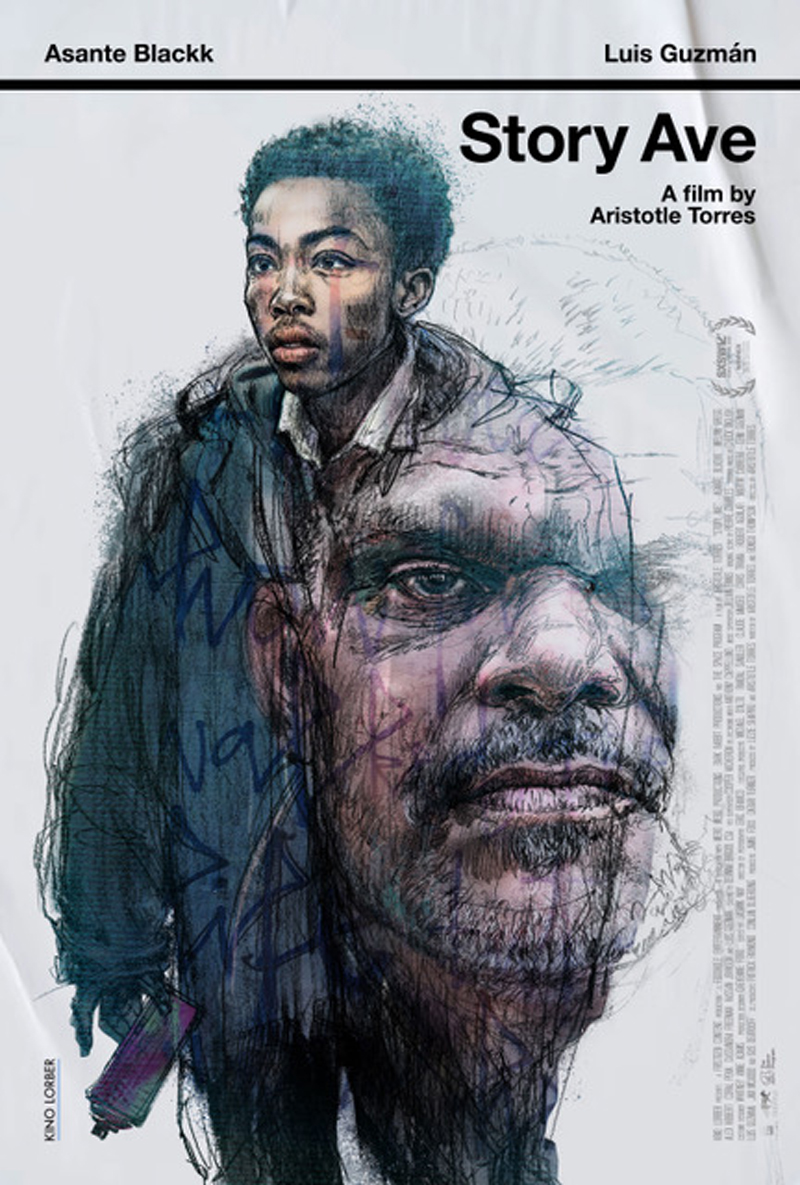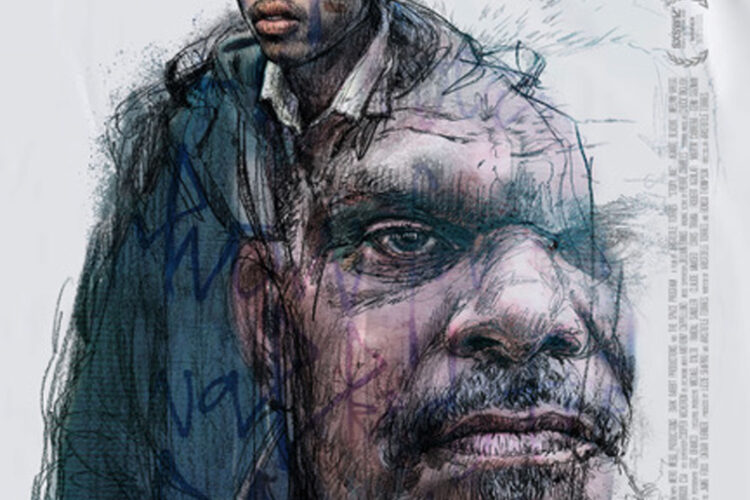
Aristotle Torres
Story Ave
Directed by Aristotle Torres
Written by Aristotle Torres and Bonsu Thompson
Starring Asante Blackk, Luis Guzmán, and Melvin Gregg
(Kino Lorber, 2023)
Kadir: “Give me your money. Give me your fucking money!”
Luis: “No.”
After a concluding title card for Aristotle Torres’s Story Ave (2023), the end credits begin with footage of New York shot through a subway car window. Nas’s “The World Is Yours” plays over the footage as the first credit for the film is displayed: “A Story by THE BRONX.” A rather bold credit, the film’s reverence for the Bronx borough of New York City comes through as palpable in Torres’s feature-length adaptation of his 2018 short. Based on a true story, Story Ave offers a compelling tale about life choices and the tracks those choices bind us to. Rather than following all the familiar conventions of, say, a hood film, Torres’s picture evokes a Bronx ethos that is as much indebted to the borough as it is irrevocably part of it. Note: this is not a film dedicated to the Bronx. Rather, it is a film emerging out of it.
The above epigraph is from the formative moment in Story Ave that encapsulates this film as a story emerging out of the Bronx. Kadir (Asante Blackk) is a teenage graffiti artist challenged by a gang leader to rob someone at gunpoint. Atop an empty Story Ave platform (a fictitious platform, yes?), Kadir brandishes his weapon at the only other passenger getting off at that stop, MTA worker Luis Torres (Luis Guzmán). Kadir aims his weapon at Luis and makes his demands. Luis, reading Kadir’s fearful body language, dismisses the demands. The incongruity of Luis’s dismissal is somewhat humorous, akin to Dustin Hoffman’s Ratso yelling “I’m walking here!” in Midnight Cowboy (1969)—a moment ad-libbed by Hoffman as an NYC taxi ignored roadblocks and nearly hit him mid-performance. But Luis’s shrug away is also heartbreaking. Luis knows this situation well, and his initial refusal to give into the robbery paints his character as an old soul with a profound knowledge of his neighborhood. Pages of dialogue could never account for what Guzmán provides through this brief gesture in his performance of Luis.
As Luis starts to walk away, he begins to barter with Kadir: he gives Kadir his wallet, then mentions there’s no money in it. He then offers his MTA coat so that Kadir doesn’t get too cold pulling stickups in the middle of the night. Eventually, Luis makes a deal with Kadir to exchange money over dinner at a restaurant below the tracks. The exchange during the robbery captures a knowledge of and care for the Bronx. Luis knows a stickup, and Kadir fails to fit the mold. Instead, Luis recognizes Kadir as a neighbor who needs help, direction, guidance. Through their negotiation, and eventual dinner below the platform, we witness an objection to the inaugural violent event of a hood picture. Torres and co-screenwriter Bonsu Thompson delicately stage the film around Kadir as a person subjected to the Bronx’s realities while also being built up by that same environment. Story Ave is not interested in telling a story about a kid getting out of the Bronx. In that manner, it takes pride in letting the Bronx breathe life into the characters and their choices.
After losing his brother in an accident, Kadir is fraught with despair, as his mother’s (Cassandra Freeman) grief takes its toll on him, and his options for college feel like they’re slipping away. Torres and cinematographer Eric Branco capture this feeling well, constantly filling half of the full frame aspect ratio through close-ups of Kadir with his surroundings in shallow focus. Blackk’s performance also works well, posturing a rough and tough exterior consistently stifled by his boyish naivete. Running away from home and finding solace in his passion for graffiti, Kadir runs crew with the Outside the Lines graffiti gang alongside his best friend Moe (Alex R. Hibbert) and Moe’s older brother and gang leader Skemes (Melvin Gregg), finding canvases among the borough’s dilapidated buildings and reclaiming their neighborhood through street art. To prove that he is about the street life and up to the OTL’s credo, Skemes orders Kadir to obtain proof that he’s stuck somebody up: “Neighborhood’s changed. Go get you some gentrification tax.”
Kadir’s initial stickup doesn’t go as planned. He ends up exchanging the weapon Skemes loans him with Luis for 300 dollars. At the end of their dinner, Luis asks Kadir to think about “how much of your problems are your fault?” Luis’s elder wisdom might sound a bit individualistic given Kadir’s circumstances, but I think the character’s earnestness and Guzmán’s empathetic performance distances the rhetorical question’s bootstrapping, self-made pitfalls. The film’s narrative tracks Kadir as he reckons with his choices, confronting some and trying to circumvent others. He gets advice from a school counselor (Sue Kim) on pursuing college, which Luis encourages by buying him art supplies. He develops a crush on waitress and SVA student Gloria (Coral Peña), who he later insults as making art “for rich folks to talk about crack babies over lobster dinner.” He tries to run with Moe and the graffiti gang but is shaken up after a violent clash with a rival troop that ends with him in jail. Luis ends up giving Kadir a place to stay and sets him up with a job for the MTA scrubbing platforms.
Eventually, Kadir will have to confront his relationship with his mother and the allegiance he owes Skemes and the OTL crew. His guilt over his brother’s death—as the older sibling in charge of looking out for his younger sibling with cerebral palsy—led him down a line right to Skemes, searching for a sense of control and an outlet for his rage and sorrow. But, unbeknownst to Kadir, that line also took him to Luis, who cautioned him to look at his tracks and plan accordingly.
A Bronx-born filmmaker, Aristotle Torres’s direction and the on-location shooting greatly benefit the film’s pacing through the second act, as we gain a sense of Kadir and Luis’s everyday interactions while witnessing Kadir’s changing perspective on his environment. The style Torres deploys throughout the film feels contemplative and passionate, for story, yes, but more so for characters and setting, similar to the likes of Gus Van Sant (thanked in the credits) and Barry Jenkins. Much of the film’s cinematography builds off the Bronx’s physicality and atmosphere: low angle shots of brick and mortar buildings occupying backgrounds, evoking a community beyond their edges; inserts and coverage containing graffiti painted buildings and street signs demarcate a reclamation of territory; the constant imagery of the subway and various stations gives us a sense of connected trajectories (whether taken or not); and neon lights reflect off the cold window panes, suffusing character’s faces with the borough’s infrastructure—a graffiti the Bronx paints onto our characters themselves. Building upon the outstanding visual language is the film’s soundscape: the Bronx emerges through echoes and murmurs bouncing off buildings, as well as the clacks and squeals of subway cars. Pierre Charles’s haunting score contributes to the film’s contemplative and sometimes magical mood, highlighting Kadir’s inner struggle and the impact of his neighborhood’s external forces. Playing into the conventions of a coming-of-age picture and against the simultaneous pessimisms and routine optimisms of a hood film, Story Ave relies on its characters and mise-en-scène to breathe into existence a film that feels familiar yet distinctly Bronx.
The film’s performances, particularly by Guzmán but also by Blackk and Gregg, give us a sense of wholly existent characters that are part and parcel of the Bronx borough. While Gregg’s Skemes castigates the authenticity of the art scene within galleries as opposed to on the streets, we gain a genuine sense of Skemes’s criticisms of a neighborhood whose identity is transforming quicker than his spray paint can keep up with. Luis, a middle-aged single man, gives us the impression of someone born and raised in the Bronx, someone who knows how the neighborhood can eat you alive if you let it. As such, he is a reminder that where you come from is part of who you are, and that with that understanding, you can make what you will of it. Late in the film, we learn that Luis had a wife and a son, and that he himself is an amalgamation of his own errors. Torres seems to want to proffer a film that is about what we learn and do out of failure, how we respond to it. Luis maybe didn’t make those decisions in time for himself, and he can’t force Kadir to do so. But he’s been around the block and knows what his considerate gestures can do.
The film culminates towards what we would expect to be a violently charged ending. Skemes is on the prowl for Kadir, who is trying to change the direction of his life. There is violence, but it doesn’t play out as we would deem conventional for a film of its kind. Instead, the film leans more into its borough’s magical charm. In front of a newly sprayed mural by Kadir of the Bronx from his perspective—the people, not the buildings—Skemes warns Kadir to not let him catch him tagging in the Bronx again, giving Kadir the out he is looking for.
Story Ave’s third act is perhaps its loosest, as it rather quickly ties up the film through a narration by Kadir. At the picture’s end, the Bronx remains as a centerpiece to Kadir’s story, both in the ways that it challenged him but also how it has built him. While some of its narrative threads conclude a bit forced, Kadir’s arc and the aura of the Bronx are well served. Story Ave was picked up by Kino Lorber following a successful premiere at the South by Southwest film festival where it won a prize for cinematography. It is playing in theaters around New York through October 12 and on November 1.
- September 29–October 5
Quad Cinema
New York, NY - October 5
Maysles Documentary Center
New York, NY - October 6–12
Concourse Plaza Cinemas
Bronx, NY - November 1
Alamo Drafthouse New York
New York, NY

